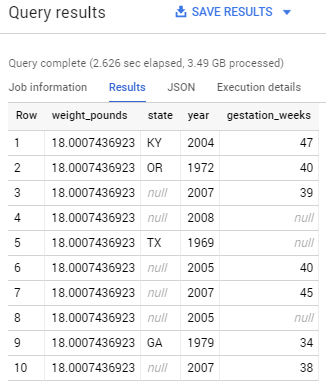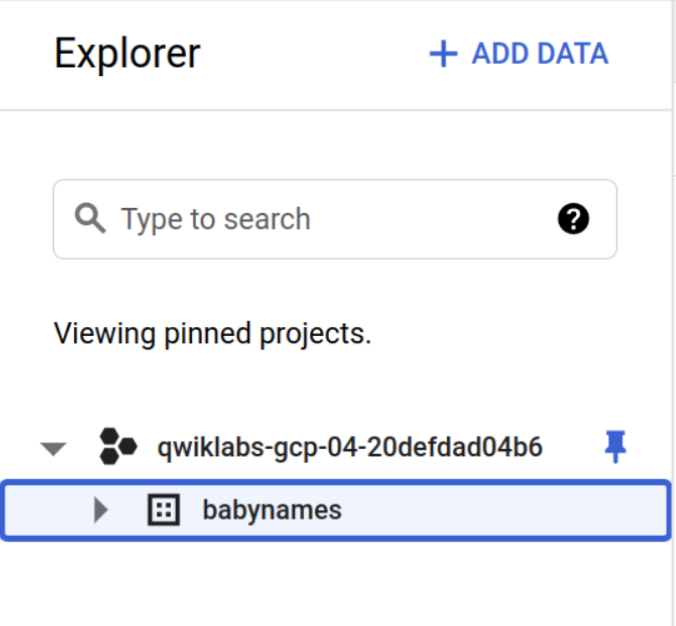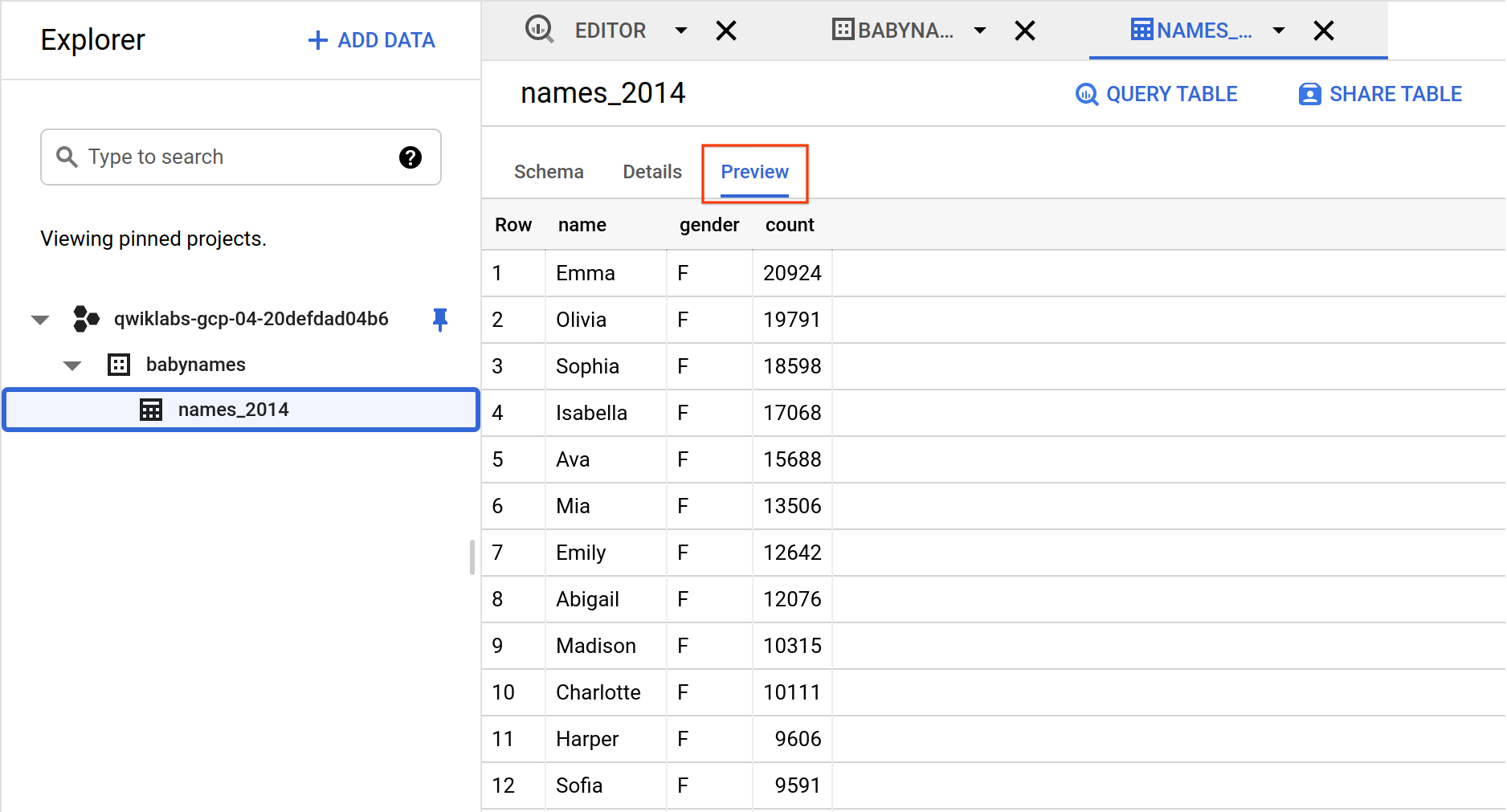Checkpoints
Query a public dataset (dataset: samples, table: natality)
/ 15
Create a new dataset
/ 30
Load data into your table
/ 40
Query a custom dataset
/ 15
BigQuery: Qwik Start - Console
GSP072
Overview
Storing and querying massive datasets can be time consuming and expensive without the right hardware and infrastructure. BigQuery is an enterprise data warehouse that solves this problem by enabling super-fast SQL queries using the processing power of Google's infrastructure. Simply move your data into BigQuery and let us handle the hard work. You can control access to both the project and your data based on your business needs, such as giving others the ability to view or query your data.
You can access BigQuery in the Console, the command-line tool, or by making calls to the BigQuery REST API using a variety of client libraries such as Java, .NET, or Python. There are also a variety of third-party tools that you can use to interact with BigQuery, such as visualizing the data or loading the data.
This hands-on lab shows you how to query public tables and load sample data into BigQuery.
What you'll do
- Query a public dataset
- Create a new dataset
- Load data into a new table
- Query a custom table
Setup and requirements
Before you click the Start Lab button
Read these instructions. Labs are timed and you cannot pause them. The timer, which starts when you click Start Lab, shows how long Google Cloud resources will be made available to you.
This hands-on lab lets you do the lab activities yourself in a real cloud environment, not in a simulation or demo environment. It does so by giving you new, temporary credentials that you use to sign in and access Google Cloud for the duration of the lab.
To complete this lab, you need:
- Access to a standard internet browser (Chrome browser recommended).
- Time to complete the lab---remember, once you start, you cannot pause a lab.
How to start your lab and sign in to the Google Cloud console
-
Click the Start Lab button. If you need to pay for the lab, a pop-up opens for you to select your payment method. On the left is the Lab Details panel with the following:
- The Open Google Cloud console button
- Time remaining
- The temporary credentials that you must use for this lab
- Other information, if needed, to step through this lab
-
Click Open Google Cloud console (or right-click and select Open Link in Incognito Window if you are running the Chrome browser).
The lab spins up resources, and then opens another tab that shows the Sign in page.
Tip: Arrange the tabs in separate windows, side-by-side.
Note: If you see the Choose an account dialog, click Use Another Account. -
If necessary, copy the Username below and paste it into the Sign in dialog.
{{{user_0.username | "Username"}}} You can also find the Username in the Lab Details panel.
-
Click Next.
-
Copy the Password below and paste it into the Welcome dialog.
{{{user_0.password | "Password"}}} You can also find the Password in the Lab Details panel.
-
Click Next.
Important: You must use the credentials the lab provides you. Do not use your Google Cloud account credentials. Note: Using your own Google Cloud account for this lab may incur extra charges. -
Click through the subsequent pages:
- Accept the terms and conditions.
- Do not add recovery options or two-factor authentication (because this is a temporary account).
- Do not sign up for free trials.
After a few moments, the Google Cloud console opens in this tab.

Activate Cloud Shell
Cloud Shell is a virtual machine that is loaded with development tools. It offers a persistent 5GB home directory and runs on the Google Cloud. Cloud Shell provides command-line access to your Google Cloud resources.
- Click Activate Cloud Shell
at the top of the Google Cloud console.
When you are connected, you are already authenticated, and the project is set to your Project_ID,
gcloud is the command-line tool for Google Cloud. It comes pre-installed on Cloud Shell and supports tab-completion.
- (Optional) You can list the active account name with this command:
- Click Authorize.
Output:
- (Optional) You can list the project ID with this command:
Output:
gcloud, in Google Cloud, refer to the gcloud CLI overview guide.
Task 1. Open BigQuery
The BigQuery console provides an interface to query tables, including public datasets offered by BigQuery. The query you will run accesses a table from a public dataset that BigQuery provides. It uses standard query language to search the dataset, and limits the results returned to 10.
Open the BigQuery console
- In the Google Cloud Console, select Navigation menu > BigQuery.
The Welcome to BigQuery in the Cloud Console message box opens. This message box provides a link to the quickstart guide and the release notes.
- Click Done.
The BigQuery console opens.
Task 2. Query a public dataset
- Click Compose a New Query. Copy and paste the following query into the BigQuery Query editor:
This data sample holds information about US natality (birth rates).
A green or red check displays depending on whether the query is valid or invalid. If the query is valid, the validator also describes the amount of data to be processed after you run the query.
This information helps determine the cost to run a query.
- Click the Run button.
Your query results should resemble the following:
Test completed task
Click Check my progress to verify your performed task. If you have successfully queried against the public dataset, you'll see an assessment score.
Task 3. Create a new dataset
To load custom data into a table, you first need to create a BigQuery dataset.
Datasets help control access to tables and views in a project. This lab uses only one table, but you still need a dataset to hold the table.
- In the Explorer pane, near your project id, click on View actions (
) then click Create dataset.
-
Set Dataset ID to babynames.
-
Leave all other fields at their default settings. Click Create dataset.
Now you have a dataset.
Test completed task
Click Check my progress to verify your performed task. If you have successfully created the BigQuery dataset, you'll see an assessment score.
Task 4. Load data into a new table
Next you create a table inside the babynames dataset, then load the data file from your storage bucket into the new table.
The custom data file you'll use contains approximately 7 MB of data about popular baby names, provided by the US Social Security Administration.
-
In the Cloud Console, select Navigation menu > BigQuery to return to the BigQuery console.
-
Navigate to the babynames dataset, by clicking View actions (
) near your dataset then click Create table.
-
In the Create table dialog, set the following fields, leave all others at the default value:
| Field | Value |
|---|---|
| Create table from | Google Cloud Storage |
| Select file from GCS bucket | spls/gsp072/baby-names/yob2014.txt |
| File format | CSV |
| Table | names_2014 |
| Schema > Edit as text | Slide on, then add the following in the textbox: name:string,gender:string,count:integer
|
- Click the Create Table button.
When BigQuery is finished creating the table and loading the data, you see the names_2014 table under the babynames dataset.
Test completed task
Click Check my progress to verify your performed task. If you have successfully loaded data into the dataset table, you'll see an assessment score.
Task 5. Preview the table
Check your table! View the first few rows of the data.
- Click the
names_2014table in the left panel, then click Preview.
Your table is ready for queries.
Task 6. Query a custom dataset
Running a query against custom data is identical to the querying a public dataset that you did earlier, except that now you're querying your own table instead of a public table.
-
In BigQuery, click the + (Compose new query) icon at the top.
-
Paste or type the following query into the query Editor.
- Click the Run button. The query displays the top 5 boys names for the year of data (2014) you loaded into the table.
Test completed task
Click Check my progress to verify your performed task. If you have successfully queried against the custom dataset, you'll see an assessment score.
Task 7. Test your understanding
Below is a true/false question to reinforce your understanding of this lab's concepts. Answer it to the best of your abilities.
Congratulations!
You used BigQuery to query public tables and load sample data into BigQuery.
Next steps / Learn more
This lab is part of a series of labs called Qwik Starts. These labs are designed to give you a little taste of the many features available with Google Cloud. Search for "Qwik Starts" in the lab catalog to find the next lab you'd like to take!
Google Cloud training and certification
...helps you make the most of Google Cloud technologies. Our classes include technical skills and best practices to help you get up to speed quickly and continue your learning journey. We offer fundamental to advanced level training, with on-demand, live, and virtual options to suit your busy schedule. Certifications help you validate and prove your skill and expertise in Google Cloud technologies.
Manual Last Updated January 26, 2024
Lab Last Tested August 25, 2023
Copyright 2024 Google LLC All rights reserved. Google and the Google logo are trademarks of Google LLC. All other company and product names may be trademarks of the respective companies with which they are associated.




